
The Paz Palace is a former mansion in Buenos Aires, Argentina, housing the Military Officers' Association, a social club maintained by the Argentine military.

The Paz Palace is a former mansion in Buenos Aires, Argentina, housing the Military Officers' Association, a social club maintained by the Argentine military.
One of Buenos Aires' most traditional social clubs, the Military Officers' Association was founded in 1881 by Nicolás Levalle, a decorated officer in the Argentine Army who believed such a facility could help mitigate tensions among the officer corps from Argentina's then-fractious provinces. The club relocated to a palace facing San Martín Plaza in 1938. The building was designed by French architect Louis Sortais and built between 1902 and 1914 at the behest of José C. Paz, the proprietor of the city's then-second most-circulated newspaper, La Prensa. Built entirely with material imported for the purpose from France, the palace stands near the eastern end of Santa Fe Avenue, in the Retiro section of Buenos Aires. [1]


The association established a number of cultural entities. The Officers' Cultural Foundation, which administers the palace as a museum and hosts lectures, expositions and concerts, is maintained in conjunction with the Catholic University of Argentina. The palace also houses the Officers' Library, a small publishing house devoted to the translation of military texts from overseas, as well as its own library, a collection of over 120,000 texts which serves as the primary resource for military history research in Argentina. [2]

The National Museum of Armaments (Spanish:Museo de Armas de la Nación) is also housed in the Paz Palace. Argentina's most important military museum, it was inaugurated in 1941 and includes 15 rooms where its collection is divided chronologically and by country of origin. Its oldest pieces include a chain mail armor belonging to the Byzantine Emperor Comnenus (c. 1100), crossbows, maces, two-handed swords, flails and other weapons dating from the Crusades, and an arquebuse used during the Battle of Aguere in Spain. The museum also houses a large collection of banners and weapons dating from the Argentine War of Independence, including a locally modified Mauser rifle prized at the time for its durability, as well as a modern artillery section tracing the development of the early machine gun during the 19th century. [2]
The library is reserved for the association's members and for researchers, though the military museum is open to the public and the Paz Palace itself can be visited through guided tours. [1]

Núñez is a barrio or neighbourhood of Buenos Aires, Argentina. It is on the northern edge of the city on the banks of the Rio de la Plata. The barrio of Belgrano is to the southeast; Saavedra and Coghlan are to the west; and Vicente López, in Buenos Aires Province, is to the north.
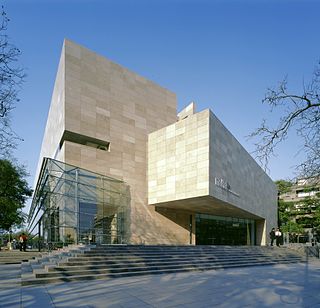
The Latin American Art Museum of Buenos Aires is a museum located on Figueroa Alcorta Avenue, in the Palermo section of Buenos Aires.

Retiro is a barrio (district) in Buenos Aires, Argentina. Located in the northeast end of the city, Retiro is bordered on the south by the Puerto Madero and San Nicolás barrios, and on the west by the Recoleta barrio.
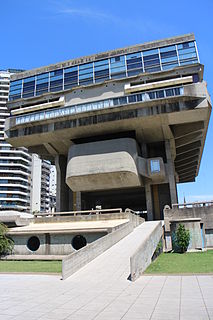
The Mariano Moreno National Library of the Argentine Republic is the largest library in Argentina. It is located in the barrio of Recoleta in Buenos Aires. The library is named after Mariano Moreno, one of the ideologists of the May Revolution and its first director.
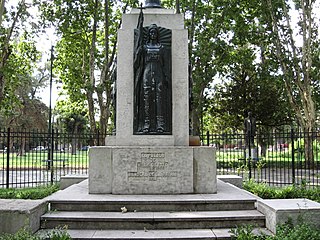
Villa Devoto is a neighborhood or district located in the northwestern area of the city of Buenos Aires, Argentina. Its administrative limits are defined by Lope de Vega, General Paz, San Martín, and Francisco Beiró Avenues; and Joaquín V. González, Baigorría, and Campana streets.

The Argentine National Historical Museum is located in Buenos Aires, Argentina, and is a museum dedicated to the history of Argentina, exhibiting objects relating to the May Revolution and the Argentine War of Independence.
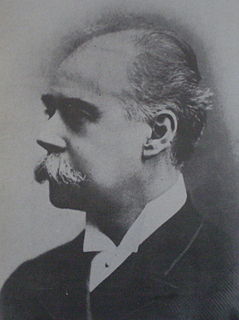
José Clemente Paz was an Argentine statesman, diplomat and journalist, founder of the La Prensa newspaper.

Plaza San Martín is a park located in the Retiro neighbourhood of Buenos Aires, Argentina. Situated at the northern end of pedestrianized Florida Street, the park is bounded by Libertador Ave. (N), Maipú St. (W), Santa Fe Avenue (S), and Leandro Alem Av. (E). Its coordinates are 34°35′42″S58°22′32″W.

Saavedra is a barrio (neighbourhood) of Buenos Aires, Argentina. It is located in the Northern end of the city, close to Belgrano and Villa Urquiza. Its northern border is Avenida General Paz. Among the main features of the neighbourhood is the Parque Saavedra, which has large picnic areas and sports facilities. Many inhabitants of Buenos Aires pass through Saavedra en route to their weekends in the country.
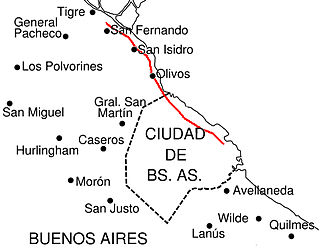
Avenida del Libertador is one of the principal thoroughfares in Buenos Aires, Argentina, and in points north, extending 25 km (16 mi) from the Retiro District of Buenos Aires to the northern suburb of San Fernando.

Córdoba Avenue is one of the principal thoroughfares in Buenos Aires, Argentina.

The Plaza Hotel Buenos Aires is a five-star hotel located in the Retiro district, just steps from Calle Florida shopping area and overlooking the Plaza San Martín.

The Buenos Aires Museum of Modern Art known locally as the Museo de Arte Moderno de Buenos Aires or MAMBA is a modern art museum located in Buenos Aires, Argentina.
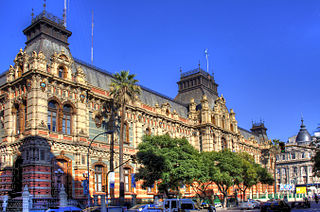
The Palace of Running Water is an architecturally significant water pumping station in Buenos Aires, Argentina.
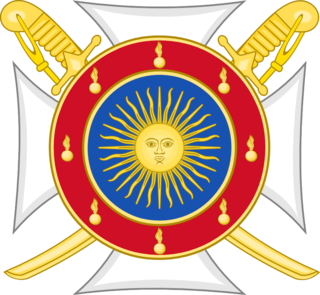
The San Martín National Institute is a cultural foundation in Buenos Aires dedicated to the legacy of General José de San Martín, the Liberator of Argentina, Chile, and Perú.

The Eduardo Sívori Museum is a municipal art museum in Buenos Aires, Argentina.

Círculo de Ex-Cadetes del Liceo Militar General San Martín, or simply Liceo Militar, is an Argentine rugby union and field hockey club sited in General San Martín Partido of Greater Buenos Aires. The rugby union team currently plays at Torneo de la URBA Grupo II, the second division of the Unión de Rugby de Buenos Aires league system.

The Museo de Arte Español Enrique Larreta is a museum of Spanish art located in the Belgrano ward of Buenos Aires, Argentina.
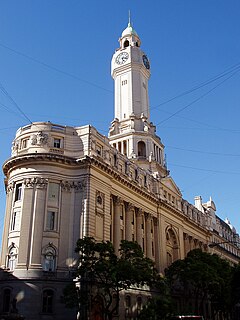
The Palacio de la Legislatura de la Ciudad de Buenos Aires houses the Government of the City of Buenos Aires, Argentina. It is an architectural landmark in the city's Montserrat district, situated in a triangular block bounded by the streets Calle Hipólito Yrigoyen, Avenida Presidente Julio Argentino Roca and Calle Perú. Built of grey granite, it has a Neoclassical design. The building is open to the public on week-days only. The building contains the Esteban Echeverría Library, Salon Rosado, and a carillon which, when it was installed in 1930, was the largest in South America.

The Tercio de Andaluces, also known as Batallón de Voluntarios Urbanos de los Cuatro Reinos de Andalucía, was a unit of Spanish militias of the city of Buenos Aires of the 19th century.